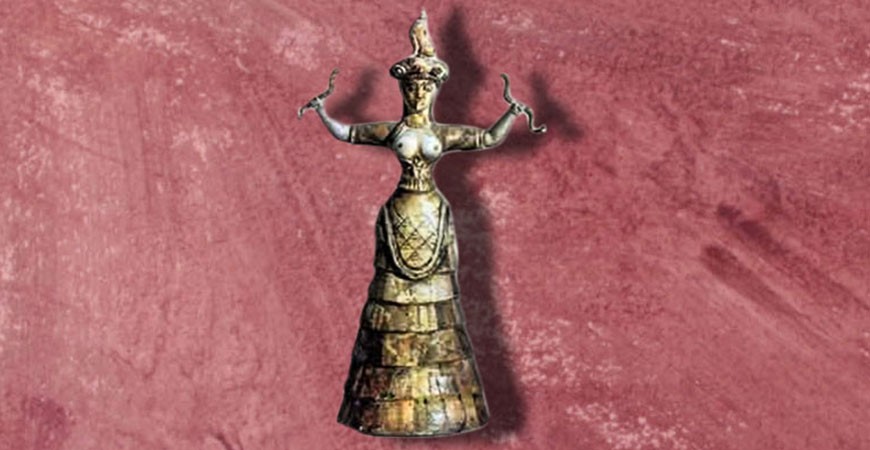- Home
- >
- Blog
- >
- Blackboard
- >
- Symbols & Findings - History & Meaning
- >
- Minoan Goddess with Snakes - History & Meaning

Minoan Goddess with Snakes - History & Meaning
The faience figurine identified as "Snake Goddess" was discovered in 1903 by Arthur Evans in the "Temple Repositories" of the Knossos palace in the island of Crete in Greece.
She is dressed in the typical Minoan clothes, with a long skirt and a tight open bodice that leaves her breasts uncovered and she holds a snake in each hand.
While the idol's true function is relatively unclear, it is believed that it represents a fertility figure. The snake, apart its chthonic symbolism is often associated with renewal of life due to the fact that it changes its skin periodically.
The fertility symbol, often mentioned as well as "Mother Goddess", is a symbol that is common in many prehistoric, stone age religions.
This belief of Mother Goddess, suppressed by Christianity, emerges again in the 18th century. Interest in this belief increased significantly during the 19th century and people became aware that this worship was not only a thing of the past, but a vivid one among many contemporary tribal people, who were in constant and direct contact with Earth.
Related articles
Medusa in Greek mythology is one of the three gorgon sisters: Medusa, Stheno and Evryali. From all three sisters,...
Snake-Serpent - History & Meaning
The snake-serpent is a very old, cross-cultural symbol. The meanings cover a wide range, from personifying the evil...
Browse our Blackboard for useful articles, meanings, properties and how-to tips. Share your knowledge on a specific...
Related products
Leave a CommentLeave a Reply
- Jewelry
- Bracelets
- Bangle Bracelets
- Braided Strap Bracelets
- Chain Bracelets
- Charm Bracelets
- Cuff Bracelets
- Link Bracelets
- Coin Bracelets
- Cross Bracelets
- Flower & Leaves Bracelets
- Heart Bracelets
- Gold Plated Sterling Silver Bracelets
- Solid Gold Bracelets
- Solid Gold & Sterling Silver Bracelets
- Sterling Silver Bracelets
- Sterling Silver & Gold Plated Silver Bracelets
- Titanium Bracelets
- Charms & Pendants
- Coin Pendants
- Egg Pendants
- Flower & Leaves Pendants
- Heart Pendants
- Intaglio - Seal Stone Pendants
- Large Pendants
- Locket Pendants
- Statement Pendants
- Gold Plated Sterling Silver Pendants
- Solid Gold Pendants
- Solid Gold & Sterling Silver Pendants
- Sterling Silver Pendants
- Sterling Silver & Bronze Pendants
- Sterling Silver & Gold Plated Silver Pendants
- Titanium Pendants
- Earrings
- Drop & Dangle Earrings
- Hoop & Half Hoop Earrings
- Long & Chandelier Earrings
- Stud Earrings
- Coin Earrings
- Cross Earrings
- Flower & Leaves Earrings
- Fringe & Tassel Earrings
- Heart Earrings
- Intaglio - Seal Stone Earrings
- Gold Plated Sterling Silver Earrings
- Solid Gold Earrings
- Solid Gold & Sterling Silver Earrings
- Sterling Silver Earrings
- Sterling Silver & Bronze Earrings
- Sterling Silver & Gold Plated Silver Earrings
- Titanium Earrings
- Necklaces
- Back Necklaces
- Chain & Multi Chain Necklaces
- Choker & Collar Necklaces
- Long Necklaces
- Pendant Necklaces
- Statement Necklaces
- Station Necklaces
- Torque Necklaces
- Coin Necklaces
- Cross Necklaces
- Flower & Leaves Necklaces
- Heart Necklaces
- Gold Plated Sterling Silver Necklaces
- Solid Gold Necklaces
- Solid Gold & Sterling Silver Necklaces
- Sterling Silver Necklaces
- Sterling Silver & Bronze Necklaces
- Sterling Silver & Gold Plated Silver Necklaces
- Titanium Necklaces
- Rings
- Band Rings
- Chevalier & Signet Rings
- Cocktail Rings
- Double Finger Rings
- Intaglio - Seal Stone Rings
- Large Rings
- Multi-Stone Rings
- Poison Rings
- Single Stone Rings
- Stackable Rings
- Swivel Flip Rings
- Wedding Bands
- Wrap Rings
- Coin Rings
- Cross Rings
- Flower & Leaves Rings
- Heart Rings
- Diamond Rings
- Pearl Rings
- Ruby Rings
- Gold Plated Sterling Silver Rings
- Solid Gold Rings
- Solid Gold & Sterling Silver Rings
- Sterling Silver Rings
- Sterling Silver & Bronze Rings
- Sterling Silver & Gold Plated Silver Rings
- Titanium Rings
- Bracelets
- Accessories
SAFETY PINS
Coming soon ! - Collections
- VIEW ALL COLLECTIONS
- The Gifts Collection
- Ancient Designs Jewelry
- Medieval-Byzantine Jewelry
- Contemporary-Modern Jewelry
- Designer Jewelry
- Amulets & Talismans Collection
- Blue Jewelry Collection
- Christening-Baptism Collection
- Coins Collection
- Crosses Collection
- Doublet Jewelry
- Eggs Collection
- Flower & Leaves Collection
- Gods & Goddesses Collection
- Greek Jewelry
- Hearts Collection
- Intaglio - Seal Stone Jewelry
- Limited Edition Collection
- Lockets Collection
- Religious Collection
- The Fringes Collection
- The Imperial Collection
- The Larimar Collection
- Trending Now
- Vintage & Collectibles
- Wedding-Bridal Collection
- Zodiac Collection
- Sterling Silver Collection
- Gold Plated Sterling Silver Collection
- Solid Gold Collection
- Solid Gold & Sterling Silver Collection
- Sterling Silver & Bronze Collection
- Sterling Silver & Gold Plated Silver Collection
- Titanium Collection
- VIEW ALL COLLECTIONS
- 200th ANNIVERSARY
- Brands
- Special Offers
- New Arrivals
- BlackBoard








